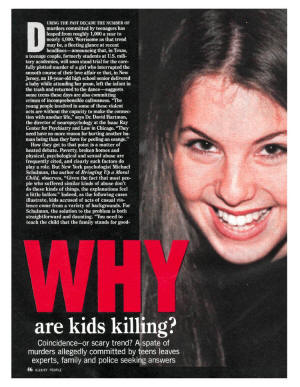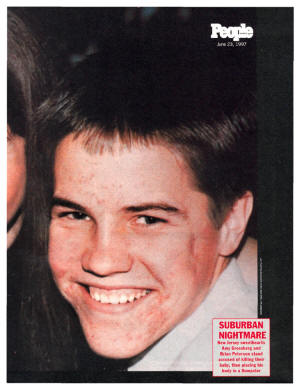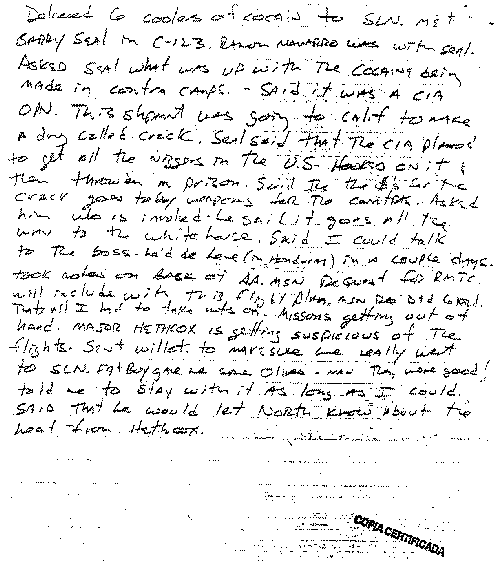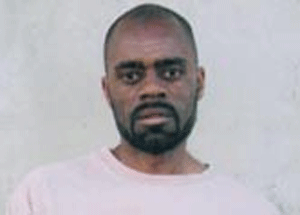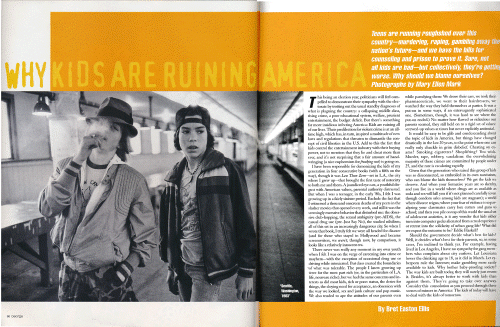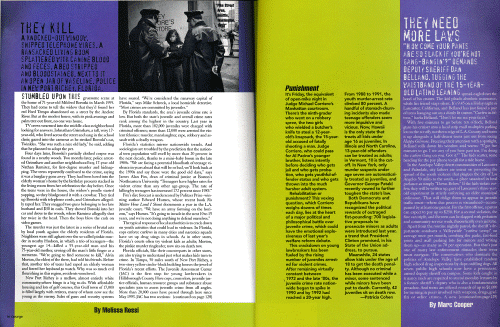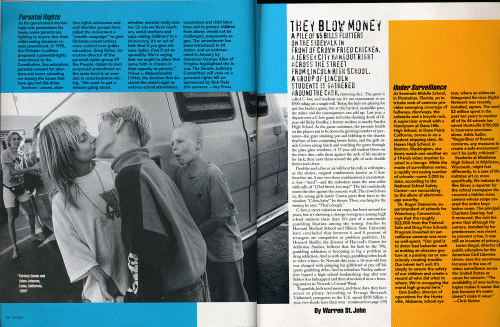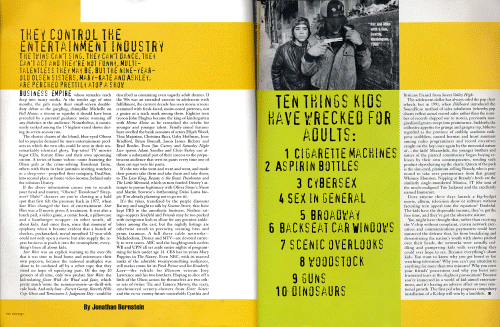by Barbara Kantrowitz
Newsweek
August 1, 1993
NOTICE: THIS WORK MAY BE PROTECTED BY COPYRIGHT
YOU ARE REQUIRED TO READ THE COPYRIGHT NOTICE AT THIS LINK BEFORE YOU READ THE FOLLOWING WORK, THAT IS AVAILABLE SOLELY FOR PRIVATE STUDY, SCHOLARSHIP OR RESEARCH PURSUANT TO 17 U.S.C. SECTION 107 AND 108. IN THE EVENT THAT THE LIBRARY DETERMINES THAT UNLAWFUL COPYING OF THIS WORK HAS OCCURRED, THE LIBRARY HAS THE RIGHT TO BLOCK THE I.P. ADDRESS AT WHICH THE UNLAWFUL COPYING APPEARED TO HAVE OCCURRED. THANK YOU FOR RESPECTING THE RIGHTS OF COPYRIGHT OWNERS.
Charles Conrad didn't have a chance. He was 55 years old, crippled by multiple sclerosis and needed a walker or wheelchair to get around. The boys who allegedly attacked him earlier this month were young--17, 15 and 14--and they were ruthless. Police say that when Conrad returned to his suburban Atlanta condominium while they were burgling it, the boys did what they had to do. They got rid of him. Permanently.
Over a period of many hours--stretching from dusk on July 17 until dawn of the next day--they stabbed him with a kitchen knife and a barbecue fork, strangled him with a rope, and hit him on the head with a hammer and the barrel of a shotgun, according to a statement one of the boys, 14-year-old Carlos Alexander Nevarez, reportedly gave to police. At one point they realized they were hungry. So they heated up the macaroni and cheese they found in Conrad's kitchen, and washed it down with Dr Pepper.
Despite this torture, Conrad survived. According to the statement published by The Atlanta Journal-Constitution, a grievously wounded Conrad begged the boys to shoot him and put a swift end to his agony. But, Nevarez said, the boys were afraid people would hear the gunshots. So they allegedly beat him some more, and then poured salt into his wounds to see if he was still alive. When his body twitched in response to the pain, they threw household knickknacks at him. After he was struck in the back by a brass eagle, "he stopped breathing," Nevarez told police. The boys then took off in Conrad's wheelchair-equipped van with their hard-earned loot: a stereo, a VCR, a camcorder and a shotgun, according to an indictment handed down last week. Even law-enforcement officials were shocked when they arrested the boys the next day. The DeKalb County district attorney, J. Tom Morgan, calls it "the worst crime scene I've ever seen."
Conrad's death was particularly gory, but it was not an isolated incident. Each day seems to bring a new horror story of vicious crimes by boys-and a few girls. Near Ft. Lauderdale, Fla., on July 14, a group of teenagers allegedly beat and stabbed a friend to death; police have yet to come up with a motive. A few days earlier in New York, a Brooklyn mother made the front pages for the saddest of distinctions: losing all three of her young sons to street violence. Some victims, such as the mentally retarded girl sexually assaulted by high school football players in Glen Ridge, NJ., get whole forests of publicity. But most victims are mourned only by the people who loved them. In February, Margaret Ensley's 17-year-old son Michael caught a bullet in the hallway of his high school in Reseda, Calif. She says a teen shot her son because he thought Michael gave him a funny look. The shooter, she says, is now serving 10 years in a youth-authority camp. "But I have life imprisonment without the possibility of parole," says Ensley, "because I won't ever have my son back again...When they were filling his crypt, I said, 'Lord, let me crawl up there with him,' because the pain was so unbearable."
Law-enforcement and public-health officials describe a virtual "epidemic" of youth violence in the last five years, spreading from the inner cities to the suburbs. "We're talking about younger and younger kids committing more and more serious crimes," says Indianapolis Prosecuting Attorney Jeff Modisett. "Violence is becoming a way of life." Much of it, but by no means all, can be found in poor neighborhoods, where a disproportionate number of victims and victimizers live side by side. But what separates one group from another is complex: being neglected or abused by parents; witnessing violence at an early age on the street or in the house; living in a culture that glamorizes youth violence in decades of movies from "A Clockwork Orange" to "Menace II Society"; the continuing mystery of evil. To that list add the most dangerous ingredient: the widespread availability of guns to kids. In a Harvard School of Public Health survey released last week, 59 percent of children in the sixth through the 12th grades said they "could get a handgun if they wanted one." More than a third of the students surveyed said they thought guns made it less likely that they would live to "a ripe old age." Cindy Rodriguez, a 14-year-old living in gang-riddled South-Central Los Angeles, is a testament to the ferocity of unrestrained firepower. Two and a half years ago, a gang bullet ripped through her body as she was talking to the mailman outside her house. Now she's paralyzed for life. And the bullets keep coming. "We hear gunshots every day," she says. "Sometimes I get scared. I'm in the shower and I hear it and I get all scared. But you have to live with the reality."
Violence is devastating this generation, as surely as polio cut down young people 40 years ago. Attorney General Janet Reno says youth violence is "the greatest single crime problem in America today." Between 1987 and 1991, the last year for which statistics are available, the number of teenagers arrested for murder around the country increased by an astounding 85 percent, according to the Department of justice. In 1991, 10- to 17-year-olds accounted for 17 percent of all violent-crime arrests; law-enforcement officials believe that figure is even higher now. Teenagers are not just the perpetrators; they're also the victims. According to the FBI, more than 2,200 murder victims in 1991 were under 18 -an average of more than six young people killed every day. The Justice Department estimates that each year, nearly a million young people between 12 and 19 are raped, robbed or assaulted, often by their peers.
That's the official count. The true number of injuries from teen violence could be even higher. When emergency medical technicians in Boston recently addressed a class of fifth graders, they were astonished to find that nearly three quarters of the children knew someone who had been shot or stabbed. "A lot of violence goes unmeasured," says Dr. Deborah Prothrow-Stith, assistant dean of the Harvard School of Public Health and author of "Deadly Consequences," a book about teen violence. Paramedic Richard Serino, who is a supervisor in the emergency room at Boston City Hospital, estimates that doctors save seven or eight wounded teens for every one who dies. Many of the "lucky ones," Serino says, end up paralyzed or with colostomy bags.
The statistics are shocking and so is the way some teenagers react when they're caught and accused of brutal crimes. "Hey, great! We've hit the big time," 17-year-old defendant Raul Omar Villareal allegedly boasted to another boy after hearing that they might be charged with murder. Villareal was one of six Houston teens arrested and charged last month in the brutal rape and strangulation of two young girls who made the fatal mistake of taking a shortcut through a wooded area where, police say, the boys were initiating two new members into their gang. In Dartmouth, Mass., this April, two 16-year-olds and one 15-year-old armed with clubs and knives barged into a high-school social-studies class and, police say, fatally stabbed a 16-year-old. One of the accused killers reportedly claimed that cult leader David Koresh was his idol and laughed about the killing afterward.
Dartmouth is a suburb of New Bedford, the sort of place city dwellers flee to, thinking they'll find a respite from city crime. While the odds may be a bit better, a picket fence and a driveway is no guarantee. Indeed, even suburban police departments around the nation have taken to keeping watch on groups they worry may develop into youth gangs. Thus far, most of these kids seem like extras from "West Side Story," bunches of boys content to deface walls and fight with clubs and chains.
The casual attitude toward violence is most acute in inner-city neighborhoods, where many youngsters have grown up to the sounds of sirens and gunshots in the night and the sight of blood-spattered sidewalks in the morning. After so many years in a war zone, trauma begins to seem normal. This is how Shaakara, a sweet-faced 6-year-old who fives in Uptown, one of Chicago's most dangerous areas, calmly describes one terrible scene she witnessed at a neighbor's apartment: "This lady, she got shot and her little baby had got cut. This man, he took the baby and cut her. He cut her on the throat. He killed the baby. All blood came out. This little boy, when he saw the baby, he called his grandmother and she came over. And you know, his grandmother got killed, but the little boy didn't get killed. He comes over to my house. That man, he took the grandmother and put her on the ground, and slammed her, and shut her in the door. Her whole body, shut in the door." After telling her tale, Shaakara smiles. "You know what I want to be when I grow up? A ballerina or a mermaid."
In this heightened atmosphere of violence, normal rules of behavior don't apply. As traditional social supports--home, school, community--have fallen away, new role models have taken their place. "It takes an entire village to raise a child, but the village isn't there for the children anymore," says Modisett, the Indianapolis prosecutor. "The only direction these kids receive is from their peers on the street, the local drug dealers and other role models who engage in criminal conduct." Katie Buckland, a Los Angeles prosecutor who volunteers in the city's schools, says the kids she sees have already given up the idea of conventional success and seize the opportunities available. "The kids that are selling crack when they're in the fifth grade are not the dumb kids," she says. "They're the smart kids. They're the ambitious kids...trying to climb up their own corporate ladder. And the only corporate ladder they see has to do with gangs and drugs."
With drugs the route to easy money, prison is the dominant institution shaping the culture, replacing church and school. In the last few years, more young black men have gone to jail than to college. Fathers, uncles, brothers, cousins have all done time. April Allen, a 15-year-old who lives in Boston's Roxbury section, has friends who think of jail as a kind of sleep-away camp. "The boys I know think it's fun to be in jail because other boys they know are in jail, too," she says. Prison is a way of looking; the dropped-waist, baggy-pants look is even called "jailing" in Miami. And prison is a way of acting. "In prison, the baddest, meanest guy runs the cell," says H. T. Smith, a lawyer and African-American activist who practices in Miami's Overtown ghetto. "Your neighborhood, your school--it's the same. You've got to show him you're crazy enough so he won't mess with you."
If prison provides the method of social interaction, guns provide the means. Alexis Vega, a 19-year-old New Yorker, explains the mentality on the streets where she grew up: "If a man threatens me, that's a threat to my life. So I go get a gun and make sure I shoot him first before he shoots me. Even though he might not mean it. just by saying it, it may scare me so much that I'm going to get him first." Vega has seen run-of-the-mill arguments turn into tragedies. "A bullet doesn't have anybody's name on it," says Vega. "Somebody shoots, they're so nervous, they'll catch you even though you don't have anything to do with it."
One kid with a gun is a finite danger; a gang equipped with Uzis, AK-47s and sawed-off shotguns means carnage. Unlike adult criminals, who usually act alone, violent teens normally move in a pack. That's typical teen behavior: hanging together. But these are well-equipped armies, not just a few kids milling outside a pizza parlor. There's a synergistic effect: one particularly aggressive kid can spur others to commit crimes they might not think of on their own. The victims are often chosen because they are perceived as weak or vulnerable, say social scientists who study children and aggression. As horrible as some of the crimes are, kids go along with the crowd rather than go it alone.
Some social scientists argue that teenage aggression is natural. In another era, they say, that aggression might have been channeled in a socially acceptable way--into the military, or hard physical labor--options that are still available to putative linebackers and soldiers. But other researchers who have studied today's violent teens say they are a new and dangerous breed. At a conference on teen-violence prevention in Washington, D. C., last week, psychologists and social workers discussed the causes of skyrocketing teen-crime rates. In one of the largest longitudinal studies of violent youth, scientists followed about 4,000 youngsters in Denver, Pittsburgh and Rochester, N.Y., for five years. By the age of 16, more than half admitted to some form of violent criminal behavior, says Terence P. Thornberry, the principal investigator in Rochester and a psychologist at the State University of New York in Albany. "Violence among teenagers is almost normative in our society," Thornberry told the conference. But not all violent teens were the same: the researchers found that 15 percent of the sample were responsible for 75 percent of the violent offenses.
What made the bad kids so bad? Thornberry and his colleagues identified a number of "risk factors" in the youths' background. "Violence does not drop out of the sky at age 15," Thornberry says. "it is part of a long developmental process that begins in early childhood." Kids who grow up in families where there is child abuse and maltreatment, spouse abuse and a history of violent behavior learn early on to act out physically when they are frustrated or upset. Poverty exacerbates the situation. Parents who haven't finished high school, who are unemployed or on welfare, or who began their families while they themselves were teenagers are more likely to have delinquent children. In New York and other big cities, counselors who work with delinquent youths say they see families with a history of generations of violence. Angela D'Arpa-Calandra, a former probation officer who now directs the juvenile Intensive Supervision Program, says she recently had such a case in Manhattan family court. When she walked into the courtroom, she saw a mother and a grandmother sitting with the 14-year-old offender. "I had the grandmother in criminal court in 1963," D'Arpa-Calandra says. "We didn't stop it there. The grandmother was 14 when she was arrested. The mother had this child when she was 14. It's like a cycle we must relive."
Problems in school also increase the likelihood that the youngster will turn to violence, the study found. People who work with young criminals report that many are barely literate. Learning disabilities are common among teens in the probation system, says Charntel Polite, a Brooklyn Probation officer who supervises 30 youthful offenders. "I have 15-or 16-year-olds in ninth or 10th grade whose reading levels are second or third grade."
Thornberry says the most effective prevention efforts concentrate on eliminating risk factors. For example, students with learning problems could get extra tutoring. Parents who have trouble maintaining discipline at home could get counseling or therapy. "Prevention programs need to start very early," Thornberry says, maybe even before elementary school. "Waiting until the teenage years is too late."
After a while, life on the streets begins to feel like home to older teenagers. Joaquin Ramos, a 19-year-old member of the Latin Counts in Detroit, says he spends his time "chillin' and hanging" with the Counts when he's not in jail. He's spent two years behind bars, but that hasn't made him turn away from the gang. The oldest of seven children, he never met his father, but he has been told that he was a member of the Bagly Boys, a popular gang a generation ago. Ramos began carrying a gun when he was 9; he became a full-fledged Count at the age of 13. He has watched three good friends--Bootis, Shadow and Showtime--die in street wars.
Bootis was shot when he left a party. "I looked right into his eyes and it looked like he was trying to say something," Ramos recalls. "There was snow on the ground and the blood from the back of his head was spreading all over it. Another buddy tried to lift his bead but the back of it was gone. He had a small hole right in the middle of his forehead. And then he was gone. He died. That was my buddy. We were real tight." He adds, "Would you say in the story that we love him and miss him and Shadow and Showtime, too?"
Some kids do manage to leave gang life, usually with the help of a supportive adult. William Jefferson, now 19, quit the Intervale gang in Boston's Roxbury section after he was shot. "My mom talked to me and told me I had to make a decision whether I wanted to do something with my life or stay on the street and possibly get killed." He started playing basketball and football at school; then he had to keep up his grades to stay on the teams. Last month he became the first of his mother's four children to graduate from high school. He plans to enter junior college this fall. Now, he says, he'll behave because "I have a lot to lose."
Two lives, two different choices. At the risk of sounding melodramatic, Joaquin Ramos and William Jefferson represent different paths for a generation at risk. The young men made their own decisions, but clearly they were influenced by those dear to them: for Ramos it was the gang, for Jefferson, his mother. Day by day, block by block, these are the small judgments that will end up governing our streets. There is little reason to be very optimistic.
On their way home from a pool party last month, two teenage girls took a shortcut into the woods, where they were viciously raped and strangled. Police arrested six alleged members of the Black N White gang.
In rural Massachusetts, Baldwin was charged with killing a 17-year-old girl with a baseball bat. The alleged motive: she wouldn't date him. He denies the charge.
Bobby Kent, the 20-year-old son of a stockbroker, was killed near a quarry pond July 14, his body stabbed, his head smashed with a bat. Police arrested six youths. One of them was his exgirlfriend, another a former pal.
Juveniles accounted for 17% of all violent-crime arrests in 1991.
Juvenile arrests for murder increased by 85% between 1987 and 1991.
Three of every 10 juvenile murder arrests involved a victim under the age of 18 in 1991.
SOURCES: OFFICE OF JUVENILE JUSTICE AND DELINQUENCY PREVENTION, U.S. JUSTICE DEPT.; FBI
Between 1987 and 1991, juvenile arrests for weapons violations increased 62%.
One out of 5 weapons arrests in 1991 was a juvenile arrest.
Black youths were arrested for weapons--law violations at a rate triple that of white youths in 1991; they were victims of homicides at a rate six times higher than whites.

